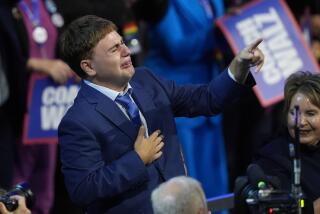Computer Program Aids Stroke Patients : Health: The combination of sight, sound and touching helps people rebuild vocabularies and function better, inventor says.
- Share via
NEVADA CITY, Calif. — When a stroke crippled Vernon Dean nearly 30 years ago, the muscular farmer lapsed into silence, his tongue stilled by the damage to the left side of his brain.
Although he could not speak, his daughter discovered that he could understand visual commands. And she found that when he touched pictures and traced them, his comprehension increased dramatically.
“When I grew older, I taught him how to read with pictures, using flash cards, That was really the starting point of the therapy. At that time, nine years after the stroke, he had a vocabulary of only nine words. That was the extent of his recovery,” Barbara Dean Schacker said.
She built upon her experiences to develop an unusual computer program to teach language to stroke victims, “starting at ground zero.”
Within 18 months, she said, her father developed a 700-word vocabulary. Before he died in 1983, he had reacquired a fundamental grasp of language and even took up painting.
“It was a remarkable recovery,” said Michael Schacker, Barbara’s husband.
The couple transferred the touch-hearing-speech techniques they developed to computer programs. The transfer took several years of research before the system was marketed in 1988.
The computer-based curriculum links words, commands and pictures, using a transparent screen that allows patients to touch the monitor to make selections. The system, which contains about 30 programs, costs about $2,000.
The Schackers said their Creative Learning Inc., based in the Sierra Nevada foothills 150 miles northeast of San Francisco, has provided the programs to more than 100,000 people.
“Even stroke patients who haven’t talked before will start to respond to this,” Barbara Schacker said. “The use of touch and sight and hearing simultaneously is what does it. It’s like starting over from the beginning, from childhood, to build a functional literacy.”
For some reason--experts are unsure why--the combination of touch, sound and sight stimulates what Barbara Schacker calls the “sensory trigger” that expedites language learning in stroke victims.
“She hears it, she sees it and she touches it,” said Martha Burns of Washington, whose 67-year-old sister suffered a stroke in April, 1991. “A year ago, she could not even read a word, and how she can go to a shopping center and sit in the car and read the signs on the stores. She can sit at the dinner table and identify the French dressing and the Russian dressing. This may not sound like a big deal, but it is.”
The program was developed to aid stroke victims, but others are also finding it useful.
The California Youth Authority, for example, plans to use it to teach language skills to young inmates, while the state prison at Chico has had it in place for two years.
The program can be adapted to people with disabilities, preschoolers and others, and is offered in Spanish.






